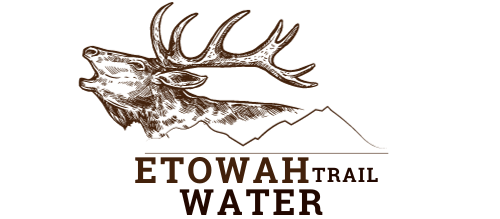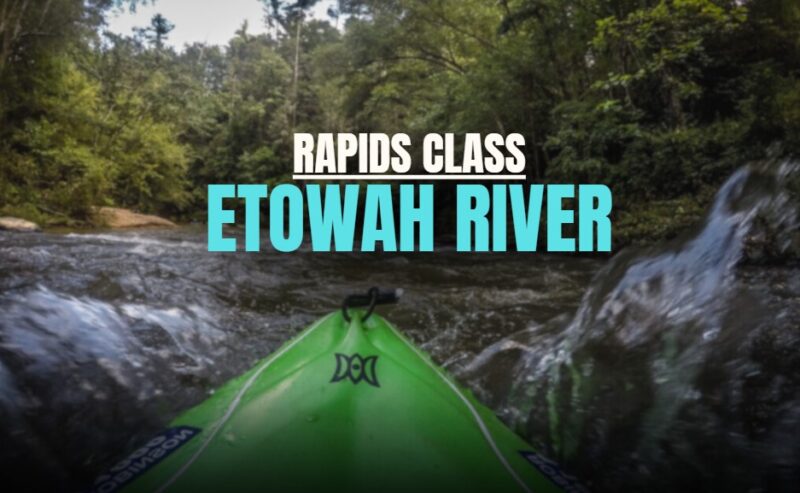Allow me to take you on a riveting virtual journey. Today, I’m going to paint a picture of a hidden gem tucked away in the vast landscape of the Southeast United States: the Etowah River. Trust me, it’s a tale worth telling and a place worth visiting.
The Etowah river snakes its way across the Georgia Piedmont, a region oozing with natural beauty. From its source in the northern parts of Georgia, it makes its way across about 164 miles before merging with the Oostanaula River and forming the Coosa. But let me tell you, it’s not just the length or location that makes the Etowah a must-visit, it’s the pulse-pounding rapids.
Understanding River Rapids Classification
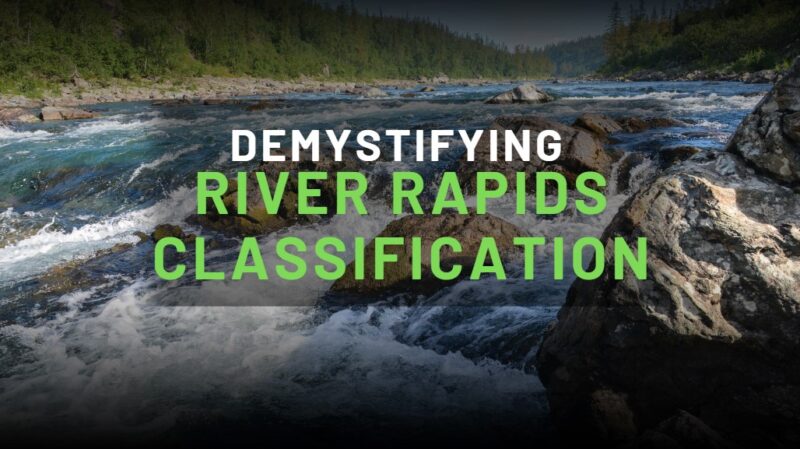
Now, before I regale you with tales of these rapids, let me stress the importance of understanding the lingo. Yep, the language of the rapids, so to speak. Much like how a sailor needs to comprehend the difference between port and starboard, us adventurers need to discern the classification of river rapids. Not just to ensure our safety, but also to squeeze out the best experience possible.
Why, you ask? Well, imagine you’re ready for a leisurely float down a river on a balmy afternoon, only to find yourself in the middle of a washing machine-like rapid. Or, let’s flip the coin; you’re ready for the thrill of a lifetime, only to float in a tame water body. Misjudging the class of the river rapids might just dampen your spirits, or worse, put you in harm’s way.
Therefore, understanding the International Scale of River Difficulty becomes paramount. Not only is it used worldwide by adventurers like us, but it also serves as a warning system of sorts, helping us understand what to expect when we’re out there, living life on the edge. But don’t worry, I’ll get to the details of each class later in our journey.
Explanation of the International Scale of River Difficulty
So, let’s get into the nitty-gritty of this International Scale of River Difficulty. It’s a lot less intimidating than it sounds, promise. Think of it as a guidebook, a tool that helps us understand the character of the rapids, and gear ourselves accordingly.
The scale ranges from Class I to Class VI:
- Class I, we’re talking easy peasy here—small waves, few or no obstructions, and a clear path to follow. Imagine a lazy Sunday afternoon picnic by the river. If you’re starting out or just looking for a calm day on the water, Class I’s your friend.
- Class II, we see things start to get a little more exciting. Moderate rapids, maybe a few rocks to watch out for, and some maneuvering might be needed. But nothing a little preparation can’t handle!
- Class III, this is where the fun begins for many of us thrill-seekers. We’re talking larger waves, maybe a few drops, and a bit more maneuvering required. It’s a bit more challenging, but oh boy, is it exhilarating!
- Class IV, this is for the experienced adventurers out there. There’s intense, powerful rapids, precise maneuvering, and a good possibility for some serious adrenaline surges.
- Class V, we’re in serious territory now. This is for experts only—long, violent rapids, steep drops, and complex routes to navigate. The risk level’s pretty high, so this isn’t something you just jump into without the right skills and experience.
- Class VI, this, my friends, is the ‘explorers only’ zone. Unpredictable, dangerous, and often unrunnable. Think of it as the Everest of river rapids.
Geography and Geology of the Etowah River
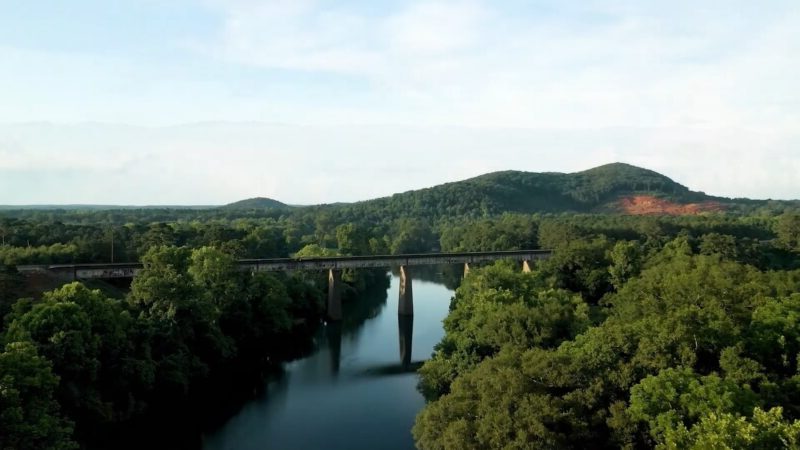
The longest free-flowing river in Georgia is filled with diverse landscapes and historical significance. Its course carves through rolling hills, meanders past towering cliffs, and stumbles upon waterfalls and forests along the way. To say that it is stunning would be an understatement. If you are a fan of waterfalls and would like to add some of them to your to-go bucket list, worry not! We’ve written a list of the most beautiful waterfalls in Georgia that you can visit with your family or as a solo adventurer.
Besides its scenic beauty, the Etowah also plays a vital role in the local ecosystem. It’s home to a wealth of biodiversity. From herons and otters to bass and bluegills, the river breathes life into the local flora and fauna.
What’s more, the river’s course and rapids are shaped by intriguing geological features. The riverbed, composed of sedimentary, metamorphic, and igneous rocks, has been weathered over millions of years. This process, combined with the forces of gravity and water flow, has carved the unique rapids we see today.
So, now we’ve covered the basics of rapid classification and got a peek into the geology and geography of the Etowah. Up next, we’re diving into the specific rapids of the Etowah, safety measures, and local attractions that make it a not-to-miss destination. Trust me, you’re in for a treat!
Rapids of the Etowah River
Now, let’s get down to the heart of the matter—the thrilling rapids of the Etowah River that make it a mecca for adventure junkies like you and me. From the tame Class I ripples to the heart-pounding Class V challenges, the Etowah has something to offer for everyone seeking an adrenaline rush.
Class I Rapids: Harmon Field to U.S. 411 Bridge
Our journey begins with the gentlest of rapids, perfect for beginners or those looking for a relaxing float down the river. The section from Harmon Field to the U.S. 411 Bridge is dotted with Class I rapids, characterized by smooth waters with few obstructions. It’s a great spot to take in the picturesque scenery and get acquainted with the art of river navigation.
Class II Rapids: U.S. 411 Bridge to Lowhead Dam

As we venture further downstream, the rapids gain a bit more oomph. This section, stretching from the U.S. 411 Bridge to the Lowhead Dam, boasts Class II rapids. You’ll find moderate waves and some maneuvering challenges here, offering a taste of excitement without being overly intimidating. It’s an excellent opportunity to hone your paddling skills.
Class III Rapids: Lowhead Dam to Dixon Landing Road
Get ready to up the ante as we approach the Lowhead Dam to Dixon Landing Road section of the river. Here, the Etowah treats us to Class III rapids, where adrenaline starts to kick in. Prepare for larger waves, technical maneuvers, and an all-around thrilling experience. It’s like going from a gentle roller coaster to a more exhilarating ride.
Class IV Rapids: Dixon Landing Road to Castleberry Bridge
Hold on tight! We’re about to take on some serious rapids. The stretch from Dixon Landing Road to Castleberry Bridge presents us with Class IV rapids. These rapids are powerful, with substantial drops and tricky obstacles. Paddlers need to be on top of their game and have solid experience to tackle this challenging section.
Class V Rapids: Castleberry Bridge to the Kelly Bridge
As we reach the Castleberry Bridge to Kelly Bridge segment, we enter the realm of Class V rapids—the pinnacle of white-water excitement. Only seasoned adventurers should attempt these rapids, as they are intense, highly technical, and demand expert-level paddling skills. But for those who are up for the challenge, the rewards are boundless.
Beyond Class V: A World of Exploration
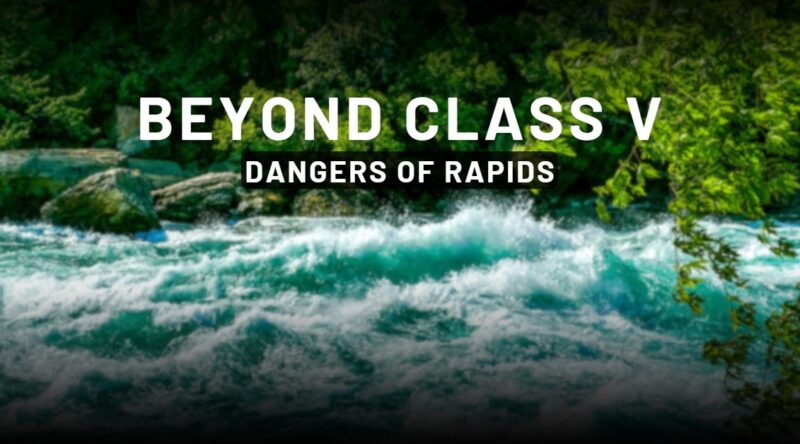
Beyond Kelly Bridge, the Etowah River reveals itself as a place of exploration and wonder. It’s a territory best left to expert kayakers and canoeists seeking new challenges and experiences. Rapids beyond Class V are untamed, unpredictable, and often involve uncharted territories, offering a canvas for exploration and discovery.
The Etowah River is a playground for river enthusiasts, accommodating all skill levels. Whether you’re a novice seeking a peaceful journey or a seasoned pro craving an adrenaline rush, this river has got you covered.
Safety and Preparation

Before we dive headfirst into the exhilarating world of Etowah River rapids, it’s crucial to emphasize the importance of safety. As experienced adventurers, we know that thrill-seeking should always go hand in hand with responsibility and preparedness. So, let’s gear up and get ready for a safe and enjoyable ride!
Prioritize Proper Equipment
First things first, ensure you have the right gear for the journey. A sturdy and well-maintained kayak or canoe, a properly fitted life jacket, a reliable helmet, and appropriate clothing are non-negotiable. Don’t skimp on safety equipment; it could save your life in challenging situations.
Gauge Your Skills
Honest self-assessment is essential. Be aware of your own paddling abilities and experience level. Attempting rapids beyond your skill level can lead to accidents and put both you and your fellow adventurers at risk. Start with easier sections and gradually work your way up as your skills improve.
Scout the Rapids
Knowledge is power, especially when navigating unknown waters. Take the time to scout each rapid before attempting to run it. Look for obstacles, hidden rocks, and potential hazards. Being aware of what lies ahead can help you plan your route and make quick decisions during the ride.
Buddy Up
Solo river adventures can be exciting, but having a reliable paddling buddy can significantly enhance safety. Having someone to watch your back and lend a hand in case of an emergency can make all the difference.
Keep a Safety Kit

Prepare a safety kit with essential items like a first-aid kit, a repair kit for your kayak or canoe, a throw bag, and a whistle. These small but vital tools can be invaluable in emergency situations.
Respect Water Levels and Weather Conditions
The water levels in the Etowah River can fluctuate, affecting the difficulty of the rapids. Be aware of recent rainfall and the river’s water levels before heading out. Also, keep a close eye on weather forecasts. Sudden storms or strong currents can turn a seemingly easy ride into a challenging one.
Paddle with Local Knowledge
If you’re new to the Etowah River, consider going on your first adventure with someone who knows the river well. Local guides or experienced paddlers familiar with the area can provide valuable insights and help you navigate the rapids more safely.
Know When to Say No
Remember, it’s perfectly okay to say no and avoid a particular rapid or section if you’re not feeling up to the challenge. Trust your instincts, and never let peer pressure push you into a risky situation.
Practice Swiftwater Rescue Techniques

Taking a swiftwater rescue course can be incredibly beneficial, even for experienced paddlers. Learning how to rescue yourself or others in tricky situations can be a lifesaver.
Always remember, the goal of any adventure is to have fun and create lasting memories. But that fun should never come at the expense of safety. So, be well-prepared, be informed, and enjoy the breathtaking beauty and thrilling rapids of the Etowah River responsibly!
FAQ
Are there any restrictions on kayaking or canoeing in the Etowah River?
Yes, there are some restrictions in certain areas. It’s essential to check local regulations and permits before embarking on your adventure.
Can I bring my own kayak or canoe, or are rentals available?
Both options are available! You can bring your own watercraft or rent one from outfitters located along the river for a hassle-free experience.
What’s the best time of year to paddle the Etowah River?
Spring and fall are ideal. The water levels are generally more predictable, and the weather is pleasant for a comfortable journey.
Are there any camping spots along the river for multi-day trips?
Absolutely! There are designated camping areas along the river’s course, perfect for extending your adventure and exploring more of the beauty.
Conclusion

Embarking on this journey to explore the Etowah River and its rapids has been nothing short of exhilarating. As a seasoned adventurer, I’ve encountered numerous rivers and landscapes, but there’s something truly special about the Etowah. Its mesmerizing beauty, diverse ecosystems, and heart-pounding rapids have left an indelible mark on my soul. From the tranquil Class I ripples that gently caress the water’s surface to the adrenaline-fueled rush of conquering the mighty Class V rapids, the Etowah caters to all levels of paddlers, offering an unforgettable experience for each adventurer seeking the thrill of a lifetime.
Beyond the thrill and excitement, however, lies a deeper lesson—an appreciation for safety and preparedness. Navigating the rapids of the Etowah River demands respect for the water’s power and a profound understanding of one’s abilities. As I’ve emphasized throughout our journey, safety should always be the compass guiding our adventures. From scouting rapids and assessing water levels to having the right equipment and paddling with companions, being prepared is paramount in ensuring a memorable yet safe experience on the river.
As I reflect on the unique tapestry of the Etowah River, its geological wonders, the awe-inspiring rapids, and the enchanting surroundings, I can’t help but feel a sense of gratitude for the opportunity to explore this hidden gem. It’s a place that reminds us of the delicate balance between adventure and responsibility, where thrill and safety dance together in harmony. So, to all fellow adventurers out there, may your journeys be filled with wonder, excitement, and above all, a deep appreciation for the natural wonders that surround us. Until we meet again on another quest for adrenaline and discovery, stay safe, be adventurous, and embrace the beauty that awaits in the great outdoors. Happy exploring!
